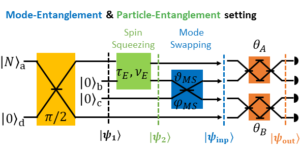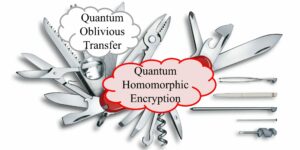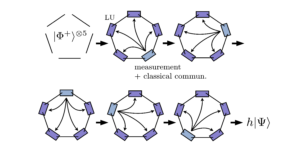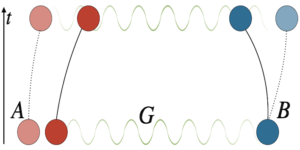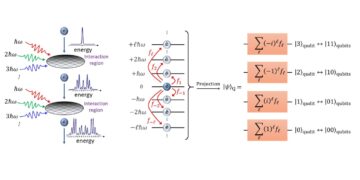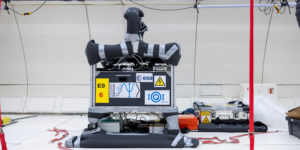Stewart Blusson Quantum Matter Institute, University of British Columbia, Vancouver V6T 1Z4, BC, Canada
Department of Physical Chemistry, University of the Basque Country UPV/EHU, Apartado 644, 48080 Bilbao, Spain
Find this paper interesting or want to discuss? Scite or leave a comment on SciRate.
Abstract
We introduce a hybrid quantum-classical variational algorithm to simulate ground-state phase diagrams of frustrated quantum spin models in the thermodynamic limit. The method is based on a cluster-Gutzwiller ansatz where the wave function of the cluster is provided by a parameterized quantum circuit whose key ingredient is a two-qubit real XY gate allowing to efficiently generate valence-bonds on nearest-neighbor qubits. Additional tunable single-qubit Z- and two-qubit ZZ-rotation gates allow the description of magnetically ordered and paramagnetic phases while restricting the variational optimization to the U(1) subspace. We benchmark the method against the $J1-J2$ Heisenberg model on the square lattice and uncover its phase diagram, which hosts long-range ordered Neel and columnar anti-ferromagnetic phases, as well as an intermediate valence-bond solid phase characterized by a periodic pattern of 2×2 strongly-correlated plaquettes. Our results show that the convergence of the algorithm is guided by the onset of long-range order, opening a promising route to synthetically realize frustrated quantum magnets and their quantum phase transition to paramagnetic valence-bond solids with currently developed superconducting circuit devices.
Featured image: Schematic loop of Q-HMFT for the 2×2 qubit cluster discussed in the paper.
Popular summary
Here, we present a VQA to simulate 2D frustrated quantum magnets in the thermodynamic limit. Building upon the cluster-Gutzwiller ansatz of hierarchical mean-field theory (HMFT), a parameterized quantum circuit provides the wave function of the cluster, while information of the infinite lattice is provided through a mean-field embedding. Benchmark numerical simulations of this textit{quantum-assisted} (Q-) HMFT on the paradigmatic J1-J2 Heisenberg antiferromagnet on the square lattice show that the convergence of the algorithm is pushed by the onset of long-range order, opening a promising route for quantum simulation of 2D quantum magnets and their quantum phase transitions to valence bond solid phases with current superconducting circuit technology.
► BibTeX data
► References
[1] J. Preskill. “Quantum Computing in the NISQ era and beyond”. Quantum 2, 79 (2018).
https://doi.org/10.22331/q-2018-08-06-79
[2] J. R. McClean, J. Romero, R. Babbush, and A. Aspuru-Guzik. “The theory of variational hybrid quantum-classical algorithms”. New Journal of Physics 18, 023023 (2016).
https://doi.org/10.1088/1367-2630/18/2/023023
[3] M. Cerezo, A. Arrasmith, R. Babbush, S. C. Benjamin, S. Endo, K. Fujii, J. R. McClean, K. Mitarai, X. Yuan, L. Cincio, et al. “Variational quantum algorithms”. Nat. Rev. Phys. 3, 625–644 (2021).
https://doi.org/10.1038/s42254-021-00348-9
[4] K. Bharti, A. Cervera-Lierta, T. H. Kyaw, T. Haug, S. Alperin-Lea, A. Anand, M. Degroote, H. Heimonen, J. S. Kottmann, T. Menke, et al. “Noisy intermediate-scale quantum algorithms”. Rev. Mod. Phys. 94, 015004 (2022).
https://doi.org/10.1103/RevModPhys.94.015004
[5] A. Peruzzo, J. McClean, P. Shadbolt, M.-H. Yung, X.-Q. Zhou, P. J. Love, A. Aspuru-Guzik, and J. L. O’Brien. “A variational eigenvalue solver on a photonic quantum processor”. Nat. Commun. 5, 4213 (2014).
https://doi.org/10.1038/ncomms5213
[6] M. A. Nielsen and I. L. Chuang. “Quantum computation and quantum information: 10th anniversary edition”. Cambridge University Press. (2010).
https://doi.org/10.1017/CBO9780511976667
[7] R. P. Feynman. “Simulating physics with computers”. Int. J. Theor. Phys. 21, 467–488 (1982).
https://doi.org/10.1007/BF02650179
[8] D. S. Abrams and S. Lloyd. “Simulation of many-body Fermi systems on a universal quantum computer”. Phys. Rev. Lett. 79, 2586–2589 (1997).
https://doi.org/10.1103/physrevlett.79.2586
[9] G. Ortiz, J. E. Gubernatis, E. Knill, and R. Laflamme. “Quantum algorithms for fermionic simulations”. Phys. Rev. A 64, 022319 (2001).
https://doi.org/10.1103/PhysRevA.64.022319
[10] R. Somma, G. Ortiz, J. E. Gubernatis, E. Knill, and R. Laflamme. “Simulating physical phenomena by quantum networks”. Phys. Rev. A 65, 042323 (2002).
https://doi.org/10.1103/physreva.65.042323
[11] D. Wecker, M. B. Hastings, and M. Troyer. “Progress towards practical quantum variational algorithms”. Phys. Rev. A 92, 042303 (2015).
https://doi.org/10.1103/PhysRevA.92.042303
[12] D. Wecker, M. B. Hastings, N. Wiebe, B. K. Clark, C. Nayak, and M. Troyer. “Solving strongly correlated electron models on a quantum computer”. Phys. Rev. A 92, 062318 (2015).
https://doi.org/10.1103/PhysRevA.92.062318
[13] Z. Jiang, K. J. Sung, K. Kechedzhi, V. N. Smelyanskiy, and S. Boixo. “Quantum algorithms to simulate many-body physics of correlated fermions”. Phys. Rev. Applied 9, 044036 (2018).
https://doi.org/10.1103/physrevapplied.9.044036
[14] J. R. McClean, S. Boixo, V. N. Smelyanskiy, R. Babbush, and H. Neven. “Barren plateaus in quantum neural network training landscapes”. Nat. Commun. 9, 4812 (2018).
https://doi.org/10.1038/s41467-018-07090-4
[15] A. Arrasmith, M. Cerezo, P. Czarnik, L. Cincio, and P. J. Coles. “Effect of barren plateaus on gradient-free optimization”. Quantum 5, 558 (2021).
https://doi.org/10.22331/q-2021-10-05-558
[16] S. Wang, E. Fontana, M. Cerezo, K. Sharma, A. Sone, L. Cincio, and P. J. Coles. “Noise-induced barren plateaus in variational quantum algorithms”. Nat. Commun. 12, 6961 (2021).
https://doi.org/10.1038/s41467-021-27045-6
[17] L. Bittel and M. Kliesch. “Training variational quantum algorithms is NP-hard”. Phys. Rev. Lett. 127, 120502 (2021).
https://doi.org/10.1103/PhysRevLett.127.120502
[18] M. Cerezo, A. Sone, T. Volkoff, L. Cincio, and P. J. Coles. “Cost function dependent barren plateaus in shallow parametrized quantum circuits”. Nat. Commun. 12, 1791 (2021).
https://doi.org/10.1038/s41467-021-21728-w
[19] Z. Holmes, K. Sharma, M. Cerezo, and P. J. Coles. “Connecting ansatz expressibility to gradient magnitudes and barren plateaus”. PRX Quantum 3, 010313 (2022).
https://doi.org/10.1103/PRXQuantum.3.010313
[20] C. Lacroix, P. Mendels, and F. Mila. “Introduction to frustrated magnetism: Materials, experiments, theory”. Springer Series in Solid-State Sciences. Springer Berlin Heidelberg. (2011).
https://doi.org/10.1007/978-3-642-10589-0
[21] N. Hatano and M. Suzuki. “Representation basis in quantum Monte Carlo calculations and the negative-sign problem”. Phys. Lett. A 163, 246–249 (1992).
https://doi.org/10.1016/0375-9601(92)91006-D
[22] M. Troyer and U.-J. Wiese. “Computational complexity and fundamental limitations to fermionic quantum Monte Carlo simulations”. Phys. Rev. Lett. 94, 170201 (2005).
https://doi.org/10.1103/PhysRevLett.94.170201
[23] M. Marvian, D. A. Lidar, and I. Hen. “On the computational complexity of curing non-stoquastic Hamiltonians”. Nat. Commun. 10, 1571 (2019).
https://doi.org/10.1038/s41467-019-09501-6
[24] M. R. Norman. “Colloquium: Herbertsmithite and the search for the quantum spin liquid”. Rev. Mod. Phys. 88, 041002 (2016).
https://doi.org/10.1103/RevModPhys.88.041002
[25] M. E. Zayed, Ch. Rüegg, J. Larrea J., A. M. Läuchli, C. Panagopoulos, S. S. Saxena, M. Ellerby, D. F. McMorrow, Th. Strässle, S. Klotz, et al. “4-spin plaquette singlet state in the Shastry–Sutherland compound SrCu$_2$(BO$_3$)$_2$”. Nat. Phys. 13, 962–966 (2017).
https://doi.org/10.1038/nphys4190
[26] Y. Zhou, K. Kanoda, and T.-K. Ng. “Quantum spin liquid states”. Rev. Mod. Phys. 89, 025003 (2017).
https://doi.org/10.1103/RevModPhys.89.025003
[27] F. Verstraete and J. I. Cirac. “Valence-bond states for quantum computation”. Phys. Rev. A 70, 060302(R) (2004).
https://doi.org/10.1103/physreva.70.060302
[28] T.-C. Wei, I. Affleck, and R. Raussendorf. “Affleck-Kennedy-Lieb-Tasaki state on a honeycomb lattice is a universal quantum computational resource”. Phys. Rev. Lett. 106, 070501 (2011).
https://doi.org/10.1103/physrevlett.106.070501
[29] A. Miyake. “Quantum computational capability of a 2D valence bond solid phase”. Ann. Phys. 326, 1656–1671 (2011).
https://doi.org/10.1016/j.aop.2011.03.006
[30] A.Yu. Kitaev. “Fault-tolerant quantum computation by anyons”. Ann. Phys. 303, 2–30 (2003).
[31] A. Kitaev. “Anyons in an exactly solved model and beyond”. Ann. Phys. 321, 2–111 (2006).
https://doi.org/10.1016/j.aop.2005.10.005
[32] C. Schön, E. Solano, F. Verstraete, J. I. Cirac, and M. M. Wolf. “Sequential generation of entangled multiqubit states”. Phys. Rev. Lett. 95, 110503 (2005).
https://doi.org/10.1103/PhysRevLett.95.110503
[33] C. Kokail, C. Maier, R. van Bijnen, T. Brydges, M. K. Joshi, P. Jurcevic, C. A. Muschik, P. Silvi, R. Blatt, C. F. Roos, and P. Zoller. “Self-verifying variational quantum simulation of lattice models”. Nature 569, 355–360 (2019).
https://doi.org/10.1038/s41586-019-1177-4
[34] M. Foss-Feig, D. Hayes, J. M. Dreiling, C. Figgatt, J. P. Gaebler, S. A. Moses, J. M. Pino, and A. C. Potter. “Holographic quantum algorithms for simulating correlated spin systems”. Phys. Rev. Research 3, 033002 (2021).
https://doi.org/10.1103/physrevresearch.3.033002
[35] F. Barratt, J. Dborin, M. Bal, V. Stojevic, F. Pollmann, and A. G. Green. “Parallel quantum simulation of large systems on small NISQ computers”. npj Quantum Inf. 7, 79 (2021).
https://doi.org/10.1038/s41534-021-00420-3
[36] R. Haghshenas, J. Gray, A. C. Potter, and G. K.-L. Chan. “Variational power of quantum circuit tensor networks”. Phys. Rev. X 12, 011047 (2022).
https://doi.org/10.1103/PhysRevX.12.011047
[37] J.-G. Liu, Y.-H. Zhang, Y. Wan, and L. Wang. “Variational quantum eigensolver with fewer qubits”. Phys. Rev. Research 1, 023025 (2019).
https://doi.org/10.1103/PhysRevResearch.1.023025
[38] C. D. Batista and G. Ortiz. “Algebraic approach to interacting quantum systems”. Adv. Phys. 53, 1–82 (2004).
https://doi.org/10.1080/00018730310001642086
[39] L Isaev, G Ortiz, and J Dukelsky. “The phase diagram of the Heisenberg antiferromagnet with four-spin interactions”. J. Phys. Condens. Matter 22, 016006 (2009).
https://doi.org/10.1088/0953-8984/22/1/016006
[40] L. Isaev, G. Ortiz, and J. Dukelsky. “Local physics of magnetization plateaux in the Shastry-Sutherland model”. Phys. Rev. Lett. 103, 177201 (2009).
https://doi.org/10.1103/PhysRevLett.103.177201
[41] L. Isaev, G. Ortiz, and J. Dukelsky. “Hierarchical mean-field approach to the ${J}_{1}text{{-}}{J}_{2}$ Heisenberg model on a square lattice”. Phys. Rev. B 79, 024409 (2009).
https://doi.org/10.1103/PhysRevB.79.024409
[42] D. Huerga, J. Dukelsky, and G. E. Scuseria. “Composite boson mapping for lattice boson systems”. Phys. Rev. Lett. 111, 045701 (2013).
https://doi.org/10.1103/physrevlett.111.045701
[43] D. Huerga, J. Dukelsky, N. Laflorencie, and G. Ortiz. “Chiral phases of two-dimensional hard-core bosons with frustrated ring exchange”. Phys. Rev. B 89, 094401 (2014).
https://doi.org/10.1103/physrevb.89.094401
[44] D. Huerga, S. Capponi, J. Dukelsky, and G. Ortiz. “Staircase of crystal phases of hard-core bosons on the kagome lattice”. Phys. Rev. B 94, 165124 (2016).
https://doi.org/10.1103/PhysRevB.94.165124
[45] F. Arute, K. Arya, R. Babbush, et al. “Quantum supremacy using a programmable superconducting processor”. Nature 574, 505–510 (2019).
https://doi.org/10.1038/s41586-019-1666-5
[46] S. Krinner, N. Lacroix, A. Remm, A. Di Paolo, E. Genois, C. Leroux, C. Hellings, S. Lazar, F. Swiadek, J. Herrmann, G. J. Norris, C. Kraglund Andersen, M. Müller, A. Blais, C. Eichler, and A. Wallraff. “Realizing repeated quantum error correction in a distance-three surface code”. Nature 605, 669–674 (2022).
https://doi.org/10.1038/s41586-022-04566-8
[47] C. Bravo-Prieto, J. Lumbreras-Zarapico, L. Tagliacozzo, and J. I. Latorre. “Scaling of variational quantum circuit depth for condensed matter systems”. Quantum 4, 272 (2020).
https://doi.org/10.22331/q-2020-05-28-272
[48] A. Kandala, A. Mezzacapo, K. Temme, M. Takita, M. Brink, J. M. Chow, and J. M. Gambetta. “Hardware-efficient variational quantum eigensolver for small molecules and quantum magnets”. Nature 549, 242–246 (2017).
https://doi.org/10.1038/nature23879
[49] P. Chandra and B. Douçot. “Possible spin-liquid state at large ${S}$ for the frustrated square Heisenberg lattice”. Phys. Rev. B 38, 9335–9338 (1988).
https://doi.org/10.1103/PhysRevB.38.9335
[50] E. Dagotto and A. Moreo. “Phase diagram of the frustrated spin-1/2 Heisenberg antiferromagnet in 2 dimensions”. Phys. Rev. Lett. 63, 2148–2151 (1989).
https://doi.org/10.1103/PhysRevLett.63.2148
[51] R. R. P. Singh and R. Narayanan. “Dimer versus twist order in the ${J}_{1}$–${J}_{2}$ model”. Phys. Rev. Lett. 65, 1072–1075 (1990).
https://doi.org/10.1103/PhysRevLett.65.1072
[52] N. Read and S. Sachdev. “Large–${N}$ expansion for frustrated quantum antiferromagnets”. Phys. Rev. Lett. 66, 1773–1776 (1991).
https://doi.org/10.1103/PhysRevLett.66.1773
[53] L. Capriotti and S. Sorella. “Spontaneous plaquette dimerization in the ${J}_{1}$–${J}_{2}$ Heisenberg model”. Phys. Rev. Lett. 84, 3173–3176 (2000).
https://doi.org/10.1103/PhysRevLett.84.3173
[54] M. Mambrini, A. Läuchli, D. Poilblanc, and F. Mila. “Plaquette valence-bond crystal in the frustrated Heisenberg quantum antiferromagnet on the square lattice”. Phys. Rev. B 74, 144422 (2006).
https://doi.org/10.1103/PhysRevB.74.144422
[55] R. Darradi, O. Derzhko, R. Zinke, J. Schulenburg, S. E. Krüger, and J. Richter. “Ground state phases of the spin-1/2 ${J}_{1}$–${J}_{2}$ heisenberg antiferromagnet on the square lattice: A high-order coupled cluster treatment”. Phys. Rev. B 78, 214415 (2008).
https://doi.org/10.1103/PhysRevB.78.214415
[56] J. Richter and J. Schulenburg. “The spin-1/2 ${J}_1$–${J}_2$ Heisenberg antiferromagnet on the square lattice: Exact diagonalization for ${N}$=40 spins”. EPJ B 73, 117–124 (2010).
https://doi.org/10.1140/epjb/e2009-00400-4
[57] H.-C. Jiang, H. Yao, and L. Balents. “Spin liquid ground state of the spin-1/2 square ${J}_1$–${J}_2$ Heisenberg model”. Phys. Rev. B 86, 024424 (2012).
https://doi.org/10.1103/physrevb.86.024424
[58] J.-F. Yu and Y.-J. Kao. “Spin-1/2 ${J}_{1}$–${J}_{2}$ Heisenberg antiferromagnet on a square lattice: A plaquette renormalized tensor network study”. Phys. Rev. B 85, 094407 (2012).
https://doi.org/10.1103/PhysRevB.85.094407
[59] W.-J. Hu, F. Becca, A. Parola, and S. Sorella. “Direct evidence for a gapless ${Z}_{2}$ spin liquid by frustrating Néel antiferromagnetism”. Phys. Rev. B 88, 060402 (2013).
https://doi.org/10.1103/PhysRevB.88.060402
[60] L. Wang, D. Poilblanc, Z.-C. Gu, X.-G. Wen, and F. Verstraete. “Constructing a gapless spin-liquid state for the spin-1/2 ${J}_1$–${J}_2$ Heisenberg model on a square lattice”. Phys. Rev. Lett. 111, 037202 (2013).
https://doi.org/10.1103/physrevlett.111.037202
[61] S.-S. Gong, W. Zhu, D. N. Sheng, O. I. Motrunich, and M. P. A. Fisher. “Plaquette ordered phase and quantum phase diagram in the spin-$frac{1}{2}$ ${J}_{1}$–${J}_{2}$ square Heisenberg model”. Phys. Rev. Lett. 113, 027201 (2014).
https://doi.org/10.1103/PhysRevLett.113.027201
[62] S. Morita, R. Kaneko, and M. Imada. “Quantum spin liquid in spin 1/2 ${J}_1$–${J}_2$ Heisenberg model on square lattice: Many-variable variational Monte Carlo study combined with quantum-number projections”. J. Phys. Soc. Japan 84, 024720 (2015).
https://doi.org/10.7566/JPSJ.84.024720
[63] L. Wang, Z.-C. Gu, F. Verstraete, and X.-G. Wen. “Tensor-product state approach to spin-1/2 square ${J}_1$-−${J}_2$ antiferromagnetic Heisenberg model: Evidence for deconfined quantum criticality”. Phys. Rev. B 94, 075143 (2016).
https://doi.org/10.1103/physrevb.94.075143
[64] L. Wang and A. W. Sandvik. “Critical level crossings and gapless spin liquid in the square-lattice spin-1/2 ${J}_1$–${J}_2$ Heisenberg antiferromagnet”. Phys. Rev. Lett. 121, 107202 (2018).
https://doi.org/10.1103/PhysRevLett.121.107202
[65] D. Huerga, A. Greco, C. Gazza, and A. Muramatsu. “Translation-invariant parent hamiltonians of valence bond crystals”. Phys. Rev. Lett. 118, 167202 (2017).
https://doi.org/10.1103/PhysRevLett.118.167202
[66] G. H. Golub and C. F. Van Loan. “Matrix computations”. Johns Hopkins University Press. Baltimore, MD (1989). 2nd edition.
[67] J. M. Arrazola, O. Di Matteo, N. Quesada, S. Jahangiri, A. Delgado, and N. Killoran. “Universal quantum circuits for quantum chemistry”. Quantum 6, 742 (2022).
https://doi.org/10.22331/q-2022-06-20-742
[68] D. M. Abrams, N. Didier, B. R. Johnson, M. P. da Silva, and C. A. Ryan. “Implementation of xy entangling gates with a single calibrated pulse”. Nat. Electron. 3, 744–750 (2020).
https://doi.org/10.1038/s41928-020-00498-1
[69] N. Lacroix, C. Hellings, C. K. Andersen, A. Di Paolo, A. Remm, S. Lazar, S. Krinner, G. J. Norris, M. Gabureac, J. Heinsoo, A. Blais, C. Eichler, and A. Wallraff. “Improving the performance of deep quantum optimization algorithms with continuous gate sets”. PRX Quantum 1, 110304 (2020).
https://doi.org/10.1103/PRXQuantum.1.020304
[70] D. González-Cuadra. “Higher-order topological quantum paramagnets”. Phys. Rev. B 105, L020403 (2022).
https://doi.org/10.1103/PhysRevB.105.L020403
[71] N. Trivedi and D. M. Ceperley. “Green-function Monte Carlo study of quantum antiferromagnets”. Phys. Rev. B 40, 2737–2740 (1989).
https://doi.org/10.1103/PhysRevB.40.2737
[72] R. H. Byrd, P. Lu, J. Nocedal, and C. Zhu. “A limited memory algorithm for bound constrained optimization”. SIAM J. Sci. Comput. 16, 1190–1208 (1995).
https://doi.org/10.1137/0916069
[73] C. Zhu, R. H. Byrd, P. Lu, and J. Nocedal. “Algorithm 778: L-BFGS-B: Fortran subroutines for large-scale bound-constrained optimization”. ACM Trans. Math. Softw. 23, 550–560 (1997).
https://doi.org/10.1145/279232.279236
[74] J. Nocedal and S. J. Wright. “Numerical optimization”. Springer. New York, NY, USA (2006). 2e edition.
https://doi.org/10.1007/978-0-387-40065-5
[75] V. Bergholm et al. “Pennylane: Automatic differentiation of hybrid quantum-classical computations” (2018). arXiv:1811.04968.
arXiv:1811.04968
[76] X.-Z. Luo, J.-G. Liu, P. Zhang, and L. Wang. “Yao.jl: Extensible, Efficient Framework for Quantum Algorithm Design”. Quantum 4, 341 (2020).
https://doi.org/10.22331/q-2020-10-11-341
[77] I. L. Markov and Y. Shi. “Simulating quantum computation by contracting tensor networks”. SIAM J. Comput. 38, 963–981 (2008).
https://doi.org/10.1137/050644756
[78] Z.-Y. Chen, Q. Zhou, C. Xue, X. Yang, G.-C. Guo, and G.-P. Guo. “64-qubit quantum circuit simulation”. Sci. Bull. 63, 964–971 (2018).
https://doi.org/10.1016/j.scib.2018.06.007
[79] S. Boixo, S. V. Isakov, V. N. Smelyanskiy, and H. Neven. “Simulation of low-depth quantum circuits as complex undirected graphical models” (2018). arXiv:1712.05384.
arXiv:1712.05384
[80] H. De Raedt, F. Jin, D. Willsch, M. Willsch, N. Yoshioka, N. Ito, S. Yuan, and K. Michielsen. “Massively parallel quantum computer simulator, eleven years later”. Comput. Phys. Commun. 237, 47–61 (2019).
https://doi.org/10.1016/j.cpc.2018.11.005
[81] C. Monroe, W. C. Campbell, L.-M. Duan, Z.-X. Gong, A. V. Gorshkov, P. W. Hess, R. Islam, K. Kim, N. M. Linke, G. Pagano, et al. “Programmable quantum simulations of spin systems with trapped ions”. Rev. Mod. Phys. 93, 025001 (2021).
https://doi.org/10.1103/revmodphys.93.025001
[82] J. Schulenburg, A. Honecker, J. Schnack, J. Richter, and H.-J. Schmidt. “Macroscopic magnetization jumps due to independent magnons in frustrated quantum spin lattices”. Phys. Rev. Lett. 88, 167207 (2002).
https://doi.org/10.1103/PhysRevLett.88.167207
[83] F. Kobayashi, K. Mitarai, and K. Fujii. “Parent hamiltonian as a benchmark problem for variational quantum eigensolvers”. Phys. Rev. A 105, 052415 (2022).
https://doi.org/10.1103/PhysRevA.105.052415
[84] R. Sagastizabal, X. Bonet-Monroig, M. Singh, M. A. Rol, C. C. Bultink, X. Fu, C. H. Price, V. P. Ostroukh, N. Muthusubramanian, A. Bruno, et al. “Experimental error mitigation via symmetry verification in a variational quantum eigensolver”. Phys. Rev. A 100, 010302 (2019).
https://doi.org/10.1103/PhysRevA.100.010302
[85] O. Higgott, D. Wang, and S. Brierley. “Variational quantum computation of excited states”. Quantum 3, 156 (2019).
https://doi.org/10.22331/q-2019-07-01-156
[86] Y. Salathé, M. Mondal, M. Oppliger, J. Heinsoo, P. Kurpiers, A. Potočnik, A. Mezzacapo, U. Las Heras, L. Lamata, E. Solano, S. Filipp, and A. Wallraff. “Digital quantum simulation of spin models with circuit quantum electrodynamics”. Phys. Rev. X 5, 021027 (2015).
https://doi.org/10.1103/PhysRevX.5.021027
[87] R. Barends, C. M. Quintana, A. G. Petukhov, Yu Chen, D. Kafri, K. Kechedzhi, R. Collins, O. Naaman, S. Boixo, F. Arute, et al. “Diabatic gates for frequency-tunable superconducting qubits”. Phys. Rev. Lett. 123, 210501 (2019).
https://doi.org/10.1103/PhysRevLett.123.210501
[88] B. Foxen et al. “Demonstrating a continuous set of two-qubit gates for near-term quantum algorithms”. Phys. Rev. Lett. 125, 120504 (2020).
https://doi.org/10.1103/PhysRevLett.125.120504
Cited by
[1] Bruno Murta, Pedro M. Q. Cruz, and J. Fernández-Rossier, “Preparing Valence-Bond-Solid states on noisy intermediate-scale quantum computers”, arXiv:2207.07725.
[2] Verena Feulner and Michael J. Hartmann, “Variational quantum eigensolver ansatz for the J1-J2 -model”, Physical Review B 106 14, 144426 (2022).
[3] Rasmus Berg Jensen, Simon Panyella Pedersen, and Nikolaj Thomas Zinner, “Dynamical quantum phase transitions in a noisy lattice gauge theory”, Physical Review B 105 22, 224309 (2022).
The above citations are from SAO/NASA ADS (last updated successfully 2022-12-14 16:23:07). The list may be incomplete as not all publishers provide suitable and complete citation data.
On Crossref’s cited-by service no data on citing works was found (last attempt 2022-12-14 16:23:05).
This Paper is published in Quantum under the Creative Commons Attribution 4.0 International (CC BY 4.0) license. Copyright remains with the original copyright holders such as the authors or their institutions.


